Super Bowl XLV Special: American Football for Dummies PART 1
 Thursday, February 3, 2011 at 10:00AM |
Thursday, February 3, 2011 at 10:00AM |  Post a Comment
Post a Comment Did I spell anything wrong in that title? God I hope not.
Alright people. Football. American Football. The real deal in my books. The sport of all sports. The reason for existence. The thing I miss the most, single handedly from the US – more than Dr. Pepper, peanut butter or even my mom – ok maybe not my mom. Well… some days maybe my mom. Not today, but like a couple weeks ago? Maybe.
Anyway. Football. I spend a lot of time defending my love for this sport and even more time defending myself for liking it. But that’s not what I’m going to do here. In fact, if you don’t like football, don’t want to learn anything about football and don’t care to ever watch a game, fuck you feel free to not read this post. However, in light of the pending Super Bowl matchup this Sunday at 6PM Central Standard Time, I felt I should lay down the rules for those of you who would like to know something prior to watching the matchup.
This is part one of a two part series. The thought of cramming all of this information into one post gave me a panic attack so I’m breaking it up. This post is all about the basics. A crash course, if you will, in football. Tomorrow, I’ll break down the actual matchup this Sunday including the teams and the Super Bowl itself. For huge football fans, please bear with me, I’m trying to simplify this a lot, so don’t get all arguey (<-- real word) with me on the technicalities.
The 10 second history of football
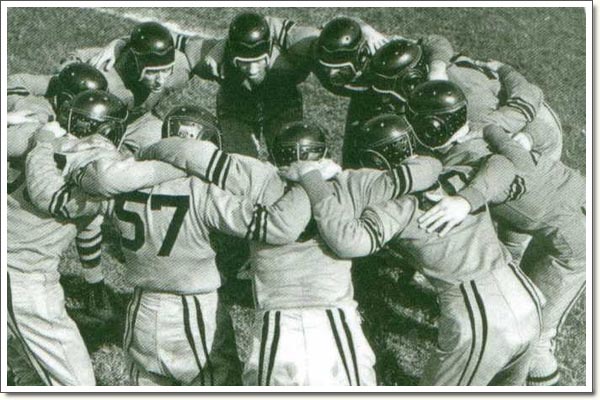
American football is sort of a derivative or combination of English football (aka Soccer in America) and Rugby. Football started as a strictly collegiate sport being played between mostly colleges located in the Northeastern US. The rules have evolved a lot since then and professional leagues were started in the late 1800’s though momentum and support really didn’t take off to today’s standards until the mid 1900’s.
The Basics
Football is played with a football. Duh. Which is a ball that is football shaped (wow, we get creative with our words here) and like… a foot long. Ok. Here’s a picture of one. Better? So the object of the game is to take the football from your end of the field down to your opponent’s end of the field and either cross the line at the end into the “end zone” or to kick the ball through the fork looking thing at the end called “goalposts.” There are 11 players on the field for each team. The team that has possession of the ball and is moving towards the opponent’s goal is the offense and the team defending their goal is the defense. The game consists of four 15 minute quarters which do not actual last 15 minutes (because the clock stops after several different types of plays) and in between each quarter there is a break period. Between the 1st and 2nd quarters and again between the 3rd and 4th quarters, there is a timeout taken and the direction of the field is changed. Between the 2nd and 3rd quarters, a longer break is taken (usually 12-15 minutes, but MUCH longer for the Super Bowl – I think 30 minutes?). The field is 100 yards long, plus space in the end zones for people to run past the goal line. The field counts up in yards from each end, culminated in the 50 yard line, which is the middle line dividing the field into two halves.
The Rules
Kickoff
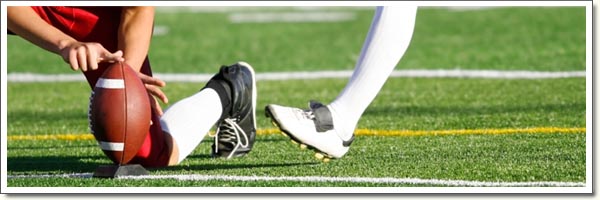
Alright, follow me here. The game starts by one team kicking the ball to the other team. This is determined by the pre-game coin toss where the winner of the coin toss gets to pick whether they want to kick or receive the first kick off. Usually, teams will choose to receive the second half kickoff as this gives them an offensive advantage later in the game. So. Team A wins the toss and decides to kick off the first half, they kick to Team B. Team A kicks the ball and the clock starts. Team B receives the ball and either waves their hands before the catch (indicating that they do not want to run it once it’s caught) or the receive it and run it. It is also important to note here, that once a players knee or lower body touches the ground, the play is stopped. If the player catches the ball in the end zone and chooses not to run it back, he can take a knee, called a “touchback” which will spot the ball at the 20 yard line.
Downs
Ok, from here, the offensive team (right now, team B) has four chances to go 10 yards. If they go the 10 yards (or farther) that have completed a “first down” and they get four more chances to go ten yards more until they reach the goal line. For instance, Team B starts on their 20 yard line, on their first try (or on first down) they run for 2 yards. It is now second down. Team B now throws for 10 yards, they have proceeded 12 yards and are on the 32 yard line. They have gone more than 10 yards so they now have a new set of four chances, it is first down. They will have to cross the 42 yard line in order to get a new first down, not the 40 yard line, since the ball was spotted at the 32 yard line. This keeps going until they get within 10 yards of the goal line. At that point, it doesn’t matter how close you are to the goal, it is “first and goal” which means you have 4 chances to get across the line. So if you are spotted on the 4 yard line, you have 4 chances to go four yards.
Offense
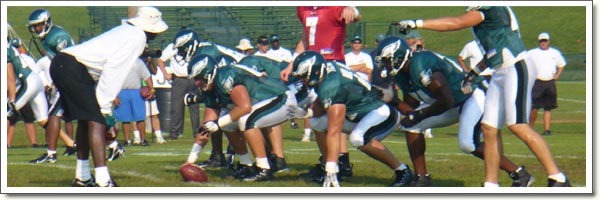
When you are on offense, there are hundreds of rules about what you can and cannot do. The most important things to know are that there are really two types of ways to progress the ball. By either throwing it or running with it. There’s all kinds of strategy and specifics but for the most part, the quarterback takes the ball from the center and then can either give it to a guy to run with it, can run with it himself or can throw it to someone down the field. The runners are generally called “running backs” and the catchers are generally either called “wide receivers” or “tight ends.” At the place where anyone holding the ball puts his knee down or gets tackled, that is where the next play will start. Also, if a player runs out of bounds (on either side) while holding the ball, the next play starts where the ball crossed the line.
Defense
Your goal on defense is to stop the person carrying the ball from going any farther. Simple as that. You are either guarding a person running trying to catch it, or trying to tackle a person actually carrying it.
Special Teams
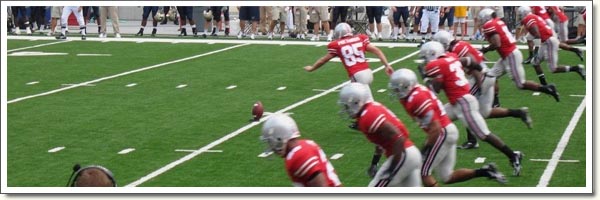
Special Teams are the groups of players that will run out on the field for special plays. Teams kick off at the beginning of the game. In addition, each time a team scores in any way, they must kick off to the other team – even if they scored a “safety” for the other team. Special teams also kick the extra points after touchdowns and punt the ball. Punting occurs if you have driven down the field, but did not make it close enough to the opponent’s goal posts to kick a field goal. In that case, on 4th down, you can opt to punt the ball to the other team for them to gain possession and start their drive for a touchdown. Special Teams also includes the players who play on defense in any of the above mentioned options.
Scoring
When your team crosses the opposing team’s goal line after you have driven down the field, you get 6 points or a “touchdown.” After you get a touchdown, you have the chance to kick for an “extra point” which is quite literally, just another point. If you choose (usually strategically) you can go for 2 points and run or throw the ball from the place you would normally kick it to get two points. If you get close to the goal line but never cross it, you can use your fourth down to kick the ball through the goalposts for 3 points. A safety (worth 2 points) occurs when the team falls behind their own goal (aka goes backwards) and goes down in their own end zone. This gives the opposing team 2 points.
Penalties
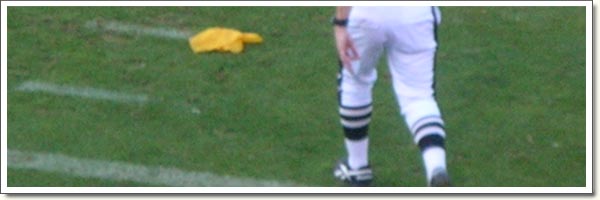
You are not allowed to do a lot of things. You’re not allowed to grab people’s face masks; you’re not allowed to hold onto defenders who are trying to tackle your quarterback. You’re not allowed to make too much contact when the ball is being thrown and you’re either trying to catch it or trying to stop someone else from catching it. You’re not allowed to throw the ball at certain points; you’re not allowed to have too many people on the field. You’re not allowed to start running around before the ball is snapped. Seeing fouls is a learned skill, so don’t worry about it too much. Just know that when a referee throws a yellow flag, somebody did something they weren’t supposed to, and it rarely gets challenged. Most penalties are punished by either rewarding yards or losing them or by adding the number of chances or “downs” you get to go 10 yards.
Change of Possession
So as we already discussed, there are several ways for the possession to change from one team to another. The first is by running out of chances, for example, getting to your 4th down and not completing your 10 yards. The second is by scoring either a touchdown, field goal or safety. The third is by a punting the ball to the opposing team on a 4th down. The final way is to lose the ball with a turnover. The first type of turnover is an interception, when the quarterback throws the ball and a player on the defensive team catches it. The other way to have a turnover is when any player with possession of the ball drops it and it is recovered by the opposing defense. All of these situations result in the possessing team to change.
So there’s my breakdown. I know it doesn’t do it even a little bit of justice. It’s a complicated game and not the easiest to follow, but hopefully that helped a little bit.


Reader Comments